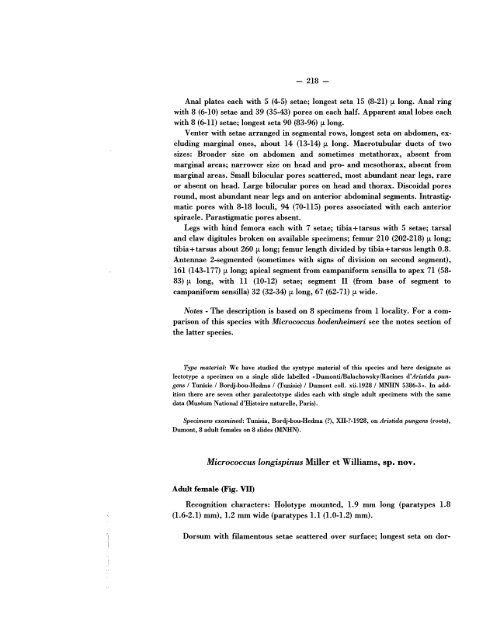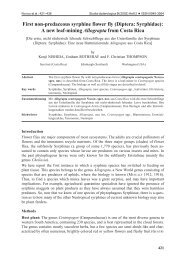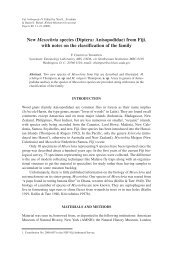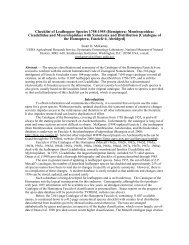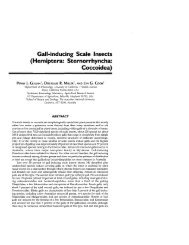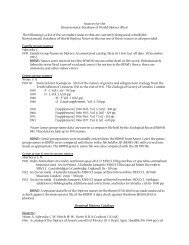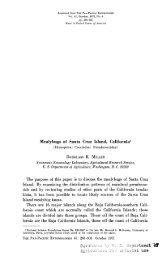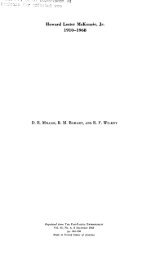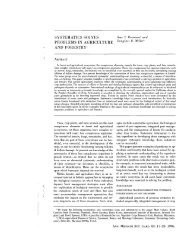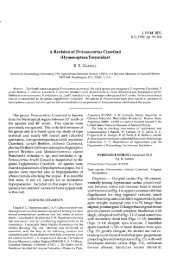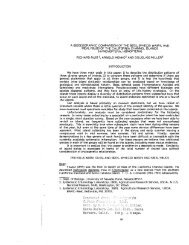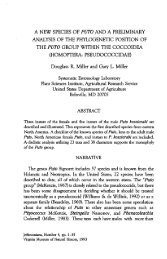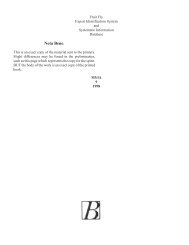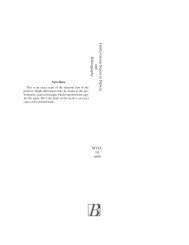Systematic revision of the Family Micrococcidae (Homoptera ...
Systematic revision of the Family Micrococcidae (Homoptera ...
Systematic revision of the Family Micrococcidae (Homoptera ...
Create successful ePaper yourself
Turn your PDF publications into a flip-book with our unique Google optimized e-Paper software.
- 218 <br />
Anal plates each with 5 (4-5) setae; longest seta 15 (8-21) fL long. Anal ring<br />
with 8 (6-10) setae and 39 (35-43) pores on each half. Apparent anal lobes each<br />
with 8 (6-11) setae; longest seta 90 (83-96) fLlong.<br />
Venter with setae arranged in segmental rows, longest seta on abdomen, excluding<br />
marginal ones, about 14 (13-14) fL long. Macrotubular ducts <strong>of</strong> two<br />
sizes: Broader size on abdomen and sometimes metathorax, absent from<br />
marginal areas; narrower size on head and pro- and mesothorax, absent from<br />
marginal areas. Small bilocular pores scattered, most abundant near legs, rare<br />
or absent on head. Large bilocular pores on head and thorax. Discoidal pores<br />
round, most abundant near legs and on anterior abdominal segments. Intrastigmatic<br />
pores with 8-18 loculi, 94 (70-115) pores associated with each anterior<br />
spiracle. Parastigmatic pores absent.<br />
Legs with hind femora each with 7 setae; tibia+tarsus with 5 setae; tarsal<br />
and claw digitules broken on available specimens; femur 210 (202-218) fL long;<br />
tibia +tarsus about 260 fLlong; femur length divided by tibia +tarsus length 0.8.<br />
Antennae 2-segmented (sometimes with signs <strong>of</strong> division on second segment),<br />
161 (143-177) fL long; apical segment from campaniform sensilla to apex 71 (58<br />
83) fL long, with 11 (10-12) setae; segment II (from base <strong>of</strong> segment to<br />
campaniform sensilla) 32 (32-34) fL long, 67 (62-71) fL wide.<br />
Notes - The description is based on 8 specimens from 1 locality. For a comparison<br />
<strong>of</strong> this species with Micrococcus bodenheimeri see <strong>the</strong> notes section <strong>of</strong><br />
<strong>the</strong> latter species.<br />
Type material: We have studied <strong>the</strong> syntype material <strong>of</strong> this species and here designate as<br />
lectotype a specimen on a single slide labelled «DumontilBalachowskylRacines d'Aristida pungens<br />
/ Tunisie / Bordj-bou-Hedma / (Tunisie) / Dumont coll. xii.1928 / MNHN 5386-3». In addition<br />
<strong>the</strong>re are seven o<strong>the</strong>r paralectotype slides each with single adult specimens with <strong>the</strong> same<br />
data (Museum National d'Histoire naturelle, Paris).<br />
Specimens examined: Tunisia, Bordj-bou-Hedma (), XII--1928, on Aristida pungens (roots),<br />
Dumont, 8 adult females on 8 slides (MNHN).<br />
Micrococcus longispinus Miller et Williams, sp. nov.<br />
Adult female (Fig. VII)<br />
Recognition characters: Holotype mounted, 1.9 mm long (paratypes 1.8<br />
(1.6-2.1) mm), 1.2 mm wide (paratypes 1.1 (1.0-1.2) mm).<br />
Dorsum with filamentous setae scattered over surface; longest seta on dor


